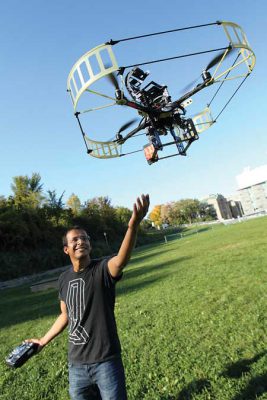
By Katherine Gombay
Right now, we still have it over robots. They may be better at mindless repetitive tasks and simple information gathering, but for the time being humans are still better at making decisions. But who knows for how long, now that researchers at McGill’s Centre for Intelligent Machines (CIM) are trying to teach robots to become intelligent information gatherers. In order to do so, robots need to learn to recognize what the norm is, so that they can also recognize what is different from it and worth paying attention to – no small task for machines that work at a binary level.
Yogesh Girdhar, a doctoral student at CIM puts the issue in context. “The main problem is – computers and robots are able to gather lots of data, terabytes of it. But how do you make sure you’re not being overloaded by lots of useless information?” he said. “It still takes a human to go through it all to look for what is unusual and surprising.”
Sifting through the data
As an example, he cites all the information collected by the telescopes used by researchers at NASA. “Right now, the most common thing is that people store everything, all the data that is gathered – but the problem is who is going to look at it all?”
The answer, Girdhar believes, lies in a program he calls ‘the summarizer.’ The idea is that, if the algorithms work as they should, robots will be able to build up data banks of information and will recognize what is different and surprising in what they are ‘seeing’ by comparing it with all the information they have already stored.
“It’s a bit like if you’re an old guy and have seen lots of different things then it’s very difficult to surprise you unless it’s aliens from Mars,” explained Girdhar. “That’s what we’re trying to do. We’re trying to make it so that as the robot sees more and more things, the threshold for what it considers interesting enough to be remembered keeps increasing.”
From blown fuses to flying robots
Girdhar first started playing with screwdrivers as a young child. He moved from blowing all the fuses in his family home with a set of magnets to shocking himself with an electrostatic machine (a precursor to the photocopier). By the time he was 13, Girdhar had set up a bulletin board system (BBS) on his first computer (this was before the Internet existed in India). It acted like a central server for friends and acquaintances to exchange files and send messages, and his parents allowed him to monopolize the family phone line between 10 p.m. and the time he went to school each morning. Eventually they allowed him to have his own dedicated phone line for the task.
Eventually Girdhar’s interest in all things mechanical led him to McGill, primarily because he wanted to work with the amphibious and flying robots.
And that is exactly what he’s doing. Girdhar is currently testing ‘the summarizer’ by using a small portable helicopter called a quad rotor that may eventually serve for such practical tasks as monitoring changes in the forest canopy. To make the summarizer work with visual input, Girdhar is also trying to train the flying robot to go from simply seeing the world in terms of pixels of different colours and textures, to seeing more abstract forms like buildings and trees.
So if you see a man at the McTavish Reservoir with a flying object hovering above his head, stop and check it out. It is probably Girdhar teaching the quad rotor to see better – giving us all a glimpse into the not-too-distant future.
